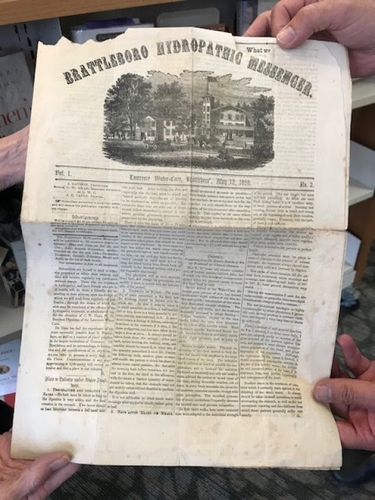BRATTLEBORO — A rare copy of the Brattleboro Hydropathic Messenger was recently donated to the Brooks Memorial Library by former library director Jerry Carbone.
Carbone is a member of the leadership team of the Brattleboro Words Project, a National Endowment for the Humanities-backed effort led by five area nonprofits to celebrate the rich but undersung history of writing, printing, and publishing in the greater Brattleboro area.
The Hydropathic Messenger was a newspaper issued by the Lawrence Water Cure from 1858 until the business closed in 1859. There appear to be only three issues held in public repositories: the Brooks Memorial Library has volumes 2 and 3 and the Wisconsin Historical Society in Madison, Wisconsin owns volume 1.
“We are thrilled to have this rare item donated to our water-cure archives,” Brooks Library Director and project leadership team member Starr LaTronica said in a news release. “We look forward to guiding classrooms and community groups on how to use our very special collections to inform these wonderful audio tours of the area."
The Hydropathic Messenger was edited by hydropathic physician and co-founder of the Lawrence Water-Cure, Charles William Grau (who died in 1861). It was printed by J.H. Capen of Brattleboro, the town's first telegraph operator and independent printer.
The publication was offered free to any subscriber, and typical articles covered, “Hints to Patients under Water Treatment,” “A Catalogue of Native Plants Around Brattleboro,” correspondence from subscribers, and even poetry.
The publication also printed railway schedules and listed the patients who came to the water-cure with dates of their stay as well as their permanent residence. The newspaper was funded by advertisements, so it is an interesting peek into the businesses of Brattleboro.
The Lawrence Water Cure was located at the current site of 118 Elliot Street.
Together with the Wesselhoeft Water Cure, which was located at the present site of the Brattleboro Fire Department, both are Brattleboro Words Project research sites because literary celebrities such as Harriet Beecher Stowe and William Wadsworth Longfellow, and many others, came to these establishments for “treatment.”
These sites will be investigated by volunteer research teams composed of classrooms and teachers, amateur historians, veterans, writers, artists and other community members who will produce audio segments and other work to be incorporated into audio walking, biking, and driving tours to create the “Brattleboro Words Trail.”
Organizers say the effort will increase both tourism and native understanding of the area's literary and historical riches.
The “Peoples, Places and History of Words in Brattleboro, Vermont” (a.k.a., the Brattleboro Words Project) is led by the Brattleboro HIstorical Society, the Brattleboro Literary Festival, Brooks Memorial Library, Write Action, and Marlboro College.
It was awarded a multi-year matching grant from the National Endowment for the Humanities in recognition of the special contribution Brattleboro makes to national cultural heritage. The Project is seeking and receiving matchable support from local funders and community members who are listed at the Project's website at BrattleboroWords.org.
